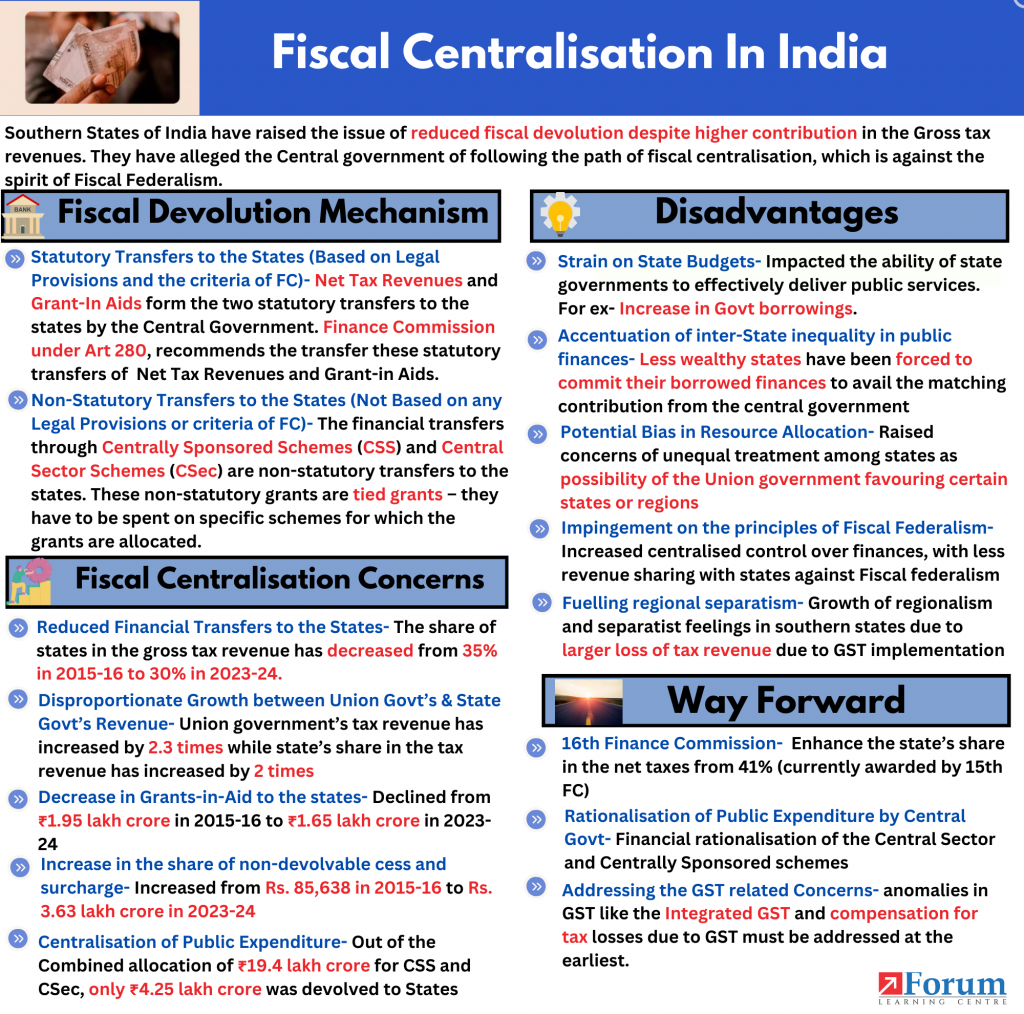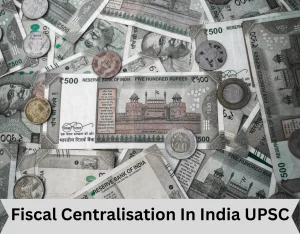ForumIAS announcing GS Foundation Program for UPSC CSE 2025-26 from 19 April. Click Here for more information.
Recently, after the presentation of the Interim Union Budget of 2024-25, remarks of an MP from South India regarding the increasing Fiscal Centralisation has caused a political uproar. Southern States have raised the issue of reduced fiscal devolution despite higher contribution in the Gross tax revenues. They have alleged the Central government of following the path of fiscal centralisation, which is against the spirit of Fiscal Federalism.

What is the Mechanism of Fiscal Devolution In India?
1. Statutory Transfers to the States (Based on Legal Provisions and the criteria of FC)- Net Tax Revenues and Grant-In Aids form the two statutory transfers to the states by the Central Government.
a. Finance Commission- Article 280 of the constitution, provides for the constitution of Finance Commission to recommend the distribution of net tax revenues between the central government and the state governments.
b. Grant in Aids- Article 275 of the constitution provides for Grant in Aids, which involves the discretionary transfer of funds from the central government to state governments for specific purposes or schemes. The Grant in Aids are recommended by the Finance Commission.
NOTE- The Finance Commission has been granted the power by the constitution to recommend only the distribution of net tax revenues among the states.
Net Tax Revenue= Gross Tax Revenue – Tax administration expenditure – Revenue collections from Union Territories – Cess and surcharge
* Thus, according to the constitution, cess and surcharges are not needed to be devolved by the Central Government to the state government.
2. Non-Statutory Transfers to the States (Not Based on any Legal Provisions or criteria of FC)- The financial transfers through Centrally Sponsored Schemes (CSS) and Central Sector Schemes (CSec) are non-statutory transfers to the states. These non-statutory grants are tied grants– they have to be spent on specific schemes for which the grants are allocated.
NOTE
Centrally Sponsored Schemes (CSS Schemes)- These schemes require matching financial contribution from the state governments from their own budgetary resources.
Central Sector Schemes (CSec Schemes)- These schemes are fully funded by the Union government in sectors where the Union government has exclusive legislative or institutional controls.
What are The Fiscal Centralisation Concerns being Raised?
1. Reduced Financial Transfers to the States- The share of states in the gross tax revenue (total tax revenue collected, which includes cess and surcharges) has decreased from 35% in 2015-16 to 30% in 2023-24.
2. Disproportionate Growth between Union Govt’s & State Govt’s Revenue- From 2015-16 to 2023-24, while the Union government’s tax revenue has increased by 2.3 times from ₹14.6 lakh crore to ₹33.6 lakh crore, the states’ share in the tax revenue has only doubled from ₹5.1 lakh crore to ₹10.2 lakh crore. This indicates a disproportionate growth between Union Govt’s and State Govt’s Revenues.
3. Decrease in Grants-in-Aid to the states- Direct financial support to states, in the form of grants-in-aid, has declined from ₹1.95 lakh crore in 2015-16 to ₹1.65 lakh crore in 2023-24.
4. Increase in the share of non-devolvable cess and surcharge- The share of collected cess and surcharge (which are not shared with states) has increased from Rs. 85,638 in 2015-16 (5.9% of the Union government’s tax revenue) to Rs. 3.63 lakh crore in 2023-24 (10.8% of the Union Govt’s tax revenue).
5. Centralisation of Public Expenditure- Out of the combined allocation of ₹19.4 lakh crore for Centrally Sponsored Schemes (CSS) and Central Sector Schemes (CSec Schemes) in 2023-24, only ₹4.25 lakh crore was devolved to States. These are tied grants and the states have no autonomy to plan their expenditure.
6. Erosion of State Taxation Autonomy on account of implementation of GST- The ability of states to set tax rates on their own revenue sources has been significantly diminished due to the implementation of GST. For ex- State VAT have been subsumed under GST.
7. Issues with GST- The compensation of revenue loss to states on account of GST implementation, have not been properly addressed. For ex- Discontinuation of GST compensation cess.
| Read More- Issue with Financial Transfers to States |
What are The Disadvantages of Fiscal Centralisation in India?
1. Strain on State Budgets- The reduction in transfers and grants to the state government have impacted the ability of state governments to effectively deliver public services. For ex- Increase in Govt borrowings.
2. Accentuation of inter-State inequality in public finances- Less wealthy states have been forced to commit their borrowed finances to avail the matching contribution from the central government for the implementation of Centrally Sponsored Scheme (CSS). This has increased the borrowings and liabilities of less-wealthy states and has accentuated inter-state inequality in public finances.
3. Potential Bias in Resource Allocation- The complete funding of Central Sector Schemes by the Central Government has raised concerns of unequal treatment among states. There is a possibility of the Union government favouring certain states or regions through Central Sector Schemes.
4. Impingement on the principles of Fiscal Federalism- Increased centralised control over finances, with less revenue sharing with states, goes against the principles of cooperative and fiscal federalism.
5. Fuelling regional separatism- The fiscal consolidation and redistribution imbalances has led to growth of regionalism and separatist feelings in southern states, as they have undergone larger loss of tax revenue on account of GST implementation.
This fiscal centralisation goes against the principle of fiscal federalism, which was displayed in the implementation of GST. However, there has been consistent decrease in the finances of state governments, which have impacted their governance.
Read More UPSC Topics-
What Should be The Way Forward to Promote Fiscal Federalism?
1. 16th Finance Commission- The 16th Finance Commission (FC) must look to enhance the state’s share in the net taxes from 41% (currently awarded by 15th FC). Further, the principles of Vertical and Horizontal devolution, must be relooked to ensure equitable distribution of taxes among the states.
2. Rationalisation of Public Expenditure by Central Govt- A mechanism must be instituted for thorough financial rationalisation of the Central Sector and Centrally Sponsored schemes, in collaboration with state governments.
3. Addressing the GST related Concerns- The anomalies in GST like the Integrated GST which favours the consuming states like UP and Bihar, rather than the producing states of TN, Gujarat must be corrected. Also, efforts must be undertaken to open more avenues for revenue generation by broadening the scope of GST to include petrol, diesel etc.
4. Revisiting Article 246 and the Seventh Schedule- The taxation powers listed in the seventh schedule must be relooked in the context of fiscal federalism. Rationalisation of Central Sector and Centrally sponsored schemes must be undertaken.
5. List of Taxation for Third Tier of Govt- Specific taxation powers must be devolved to the local self governments to help them raise their own resources and reduce their dependence on grant-in-aids. This will help in achieving fiscal federalism in its true sense.
| Read More- The Hindu UPSC Syllabus- GS 2- Issues pertaining to centre-state relations |





